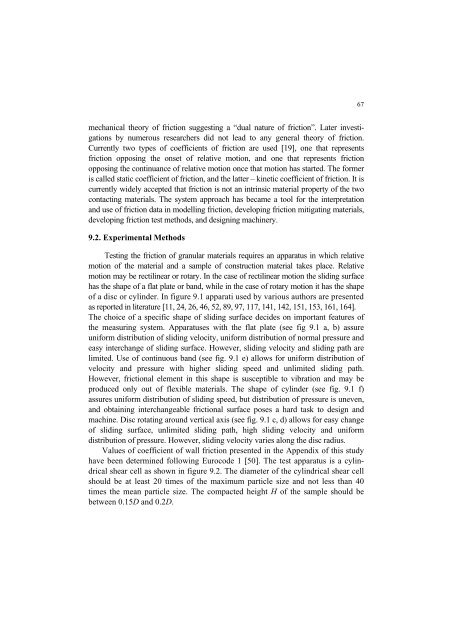Strona 2_redak - Instytut Agrofizyki im. Bohdana DobrzaÅskiego ...
Strona 2_redak - Instytut Agrofizyki im. Bohdana DobrzaÅskiego ...
Strona 2_redak - Instytut Agrofizyki im. Bohdana DobrzaÅskiego ...
Create successful ePaper yourself
Turn your PDF publications into a flip-book with our unique Google optimized e-Paper software.
67<br />
mechanical theory of friction suggesting a “dual nature of friction”. Later investigations<br />
by numerous researchers did not lead to any general theory of friction.<br />
Currently two types of coefficients of friction are used [19], one that represents<br />
friction opposing the onset of relative motion, and one that represents friction<br />
opposing the continuance of relative motion once that motion has started. The former<br />
is called static coefficient of friction, and the latter – kinetic coefficient of friction. It is<br />
currently widely accepted that friction is not an intrinsic material property of the two<br />
contacting materials. The system approach has became a tool for the interpretation<br />
and use of friction data in modelling friction, developing friction mitigating materials,<br />
developing friction test methods, and designing machinery.<br />
9.2. Exper<strong>im</strong>ental Methods<br />
Testing the friction of granular materials requires an apparatus in which relative<br />
motion of the material and a sample of construction material takes place. Relative<br />
motion may be rectilinear or rotary. In the case of rectilinear motion the sliding surface<br />
has the shape of a flat plate or band, while in the case of rotary motion it has the shape<br />
of a disc or cylinder. In figure 9.1 apparati used by various authors are presented<br />
as reported in literature [11, 24, 26, 46, 52, 89, 97, 117, 141, 142, 151, 153, 161, 164].<br />
The choice of a specific shape of sliding surface decides on <strong>im</strong>portant features of<br />
the measuring system. Apparatuses with the flat plate (see fig 9.1 a, b) assure<br />
uniform distribution of sliding velocity, uniform distribution of normal pressure and<br />
easy interchange of sliding surface. However, sliding velocity and sliding path are<br />
l<strong>im</strong>ited. Use of continuous band (see fig. 9.1 e) allows for uniform distribution of<br />
velocity and pressure with higher sliding speed and unl<strong>im</strong>ited sliding path.<br />
However, frictional element in this shape is susceptible to vibration and may be<br />
produced only out of flexible materials. The shape of cylinder (see fig. 9.1 f)<br />
assures uniform distribution of sliding speed, but distribution of pressure is uneven,<br />
and obtaining interchangeable frictional surface poses a hard task to design and<br />
machine. Disc rotating around vertical axis (see fig. 9.1 c, d) allows for easy change<br />
of sliding surface, unl<strong>im</strong>ited sliding path, high sliding velocity and uniform<br />
distribution of pressure. However, sliding velocity varies along the disc radius.<br />
Values of coefficient of wall friction presented in the Appendix of this study<br />
have been determined following Eurocode 1 [50]. The test apparatus is a cylindrical<br />
shear cell as shown in figure 9.2. The diameter of the cylindrical shear cell<br />
should be at least 20 t<strong>im</strong>es of the max<strong>im</strong>um particle size and not less than 40<br />
t<strong>im</strong>es the mean particle size. The compacted height H of the sample should be<br />
between 0.15D and 0.2D.
















